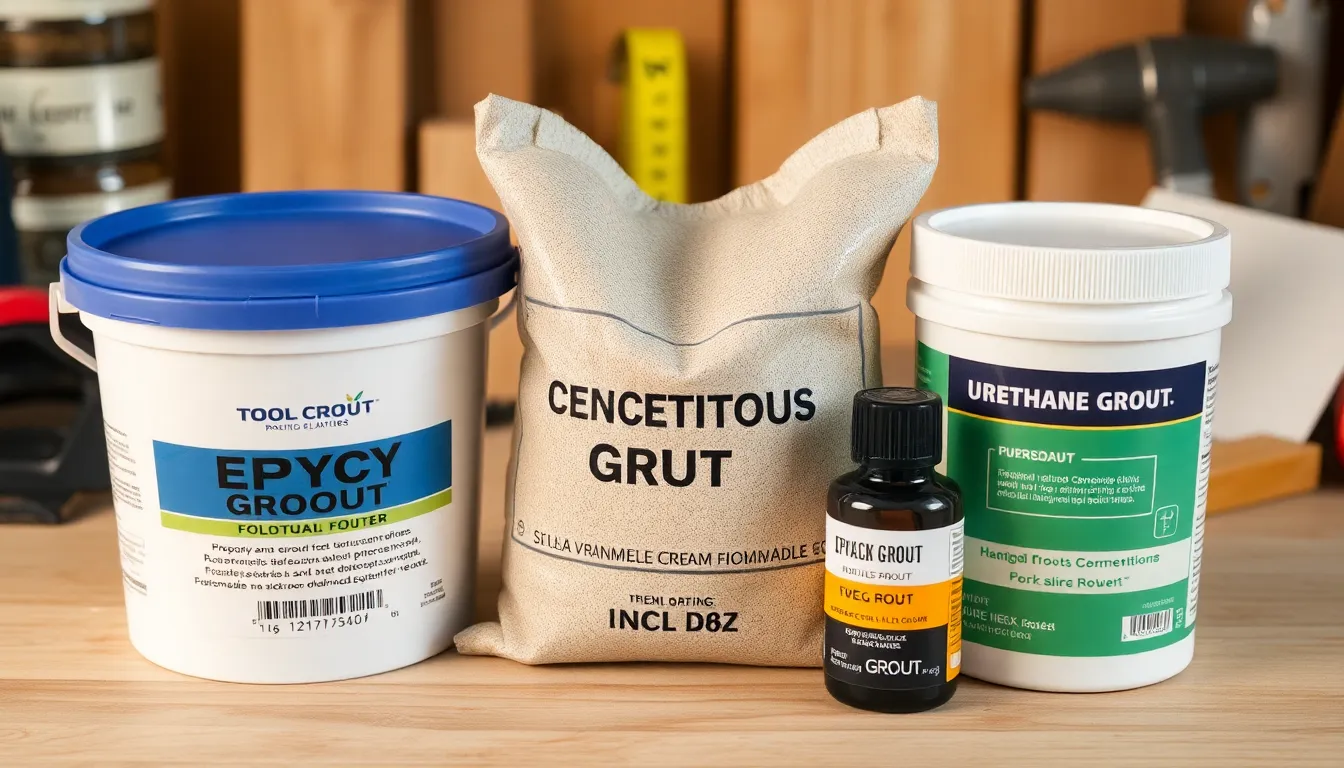Tool grout plays a crucial role in ensuring the longevity and performance of various construction and repair projects. This specialized material fills gaps and voids between tiles, bricks, and other surfaces, creating a solid bond that enhances durability. Whether it’s for a home renovation or a large-scale commercial project, understanding tool grout can make all the difference in achieving a professional finish.
With a variety of types and applications available, choosing the right tool grout can seem overwhelming. From epoxy to cement-based options, each type offers unique benefits and properties suited for different environments. Exploring these options not only simplifies the selection process but also empowers individuals to make informed decisions that lead to successful outcomes.
Table of Contents
ToggleWhat Is Tool Grout?
Tool grout refers to a specialized material used primarily in construction and repair applications for filling gaps between surfaces. Tool grout enhances stability, supports load-bearing structures, and prevents moisture infiltration. Its composition includes various binders and aggregates, determining its type and suitability for specific projects.
Types of tool grout include:
- Cement-based grout: Often used for tile installations, it consists of Portland cement and aggregate. It’s versatile and suited for general applications.
- Epoxy grout: This durable option includes epoxy resin and hardeners. Its resistance to stains and chemicals makes it ideal for high-traffic areas and environments exposed to harsh conditions.
- Urethane grout: This flexible formulation combines urethane polymers. It’s excellent for outdoor applications where temperature variations occur.
Understanding these grout types helps in selecting the right material for each project, ensuring long-lasting results and professional finishes.
Types of Tool Grout

Understanding the different types of tool grout helps in selecting the right option for specific projects. The three main types include epoxy grout, cementitious grout, and urethane grout, each designed for distinct applications.
Epoxy Grout
Epoxy grout consists of a resin and hardener, providing a strong, durable bond. This grout is stain-resistant, making it ideal for high-traffic areas and surfaces exposed to moisture. Epoxy grout withstands chemicals and is appropriate for residential and commercial kitchens and bathrooms. It also has low permeability, reducing the chance of mold and mildew growth, contributing to healthier indoor environments.
Cementitious Grout
Cementitious grout combines cement, water, and aggregates, offering versatility for various applications. This type is often used for filling joints in tile and stone installations, delivering good adhesion and strength. Cementitious grout is ideal for interior and exterior projects, including flooring, walls, and patios. While it may require sealing to prevent staining, it stands as a popular choice due to its cost-effectiveness and ease of application.
Benefits of Using Tool Grout
Tool grout offers several key benefits, enhancing both the performance and longevity of construction projects by addressing critical needs in surface applications.
Durability
Durability stands out as a significant advantage of tool grout. Tool grout forms a robust bond that withstands wear and tear, particularly in high-traffic areas. Epoxy grout features a resin and hardener formulation that is highly resistant to cracking, chipping, and peeling. Cementitious grout, despite being softer than epoxy, provides a reliable finish for various installations and is effective for interior and exterior environments. Urethane grout supports flexibility, making it suitable for surfaces that may expand or contract. Overall, using tool grout improves the lifespan of installed materials and reduces the need for repairs and replacements.
Water Resistance
Water resistance is another critical benefit of tool grout. Epoxy grout is renowned for its low permeability, effectively preventing water infiltration. This quality reduces the risk of moisture-related damage, such as mold and mildew growth, especially in areas exposed to humidity. Cementitious grout typically requires sealing to enhance its water resistance, making it a versatile option for both wet and dry applications. Urethane grout provides additional moisture protection while maintaining flexibility, accommodating movement in various environments. Employing tool grout helps safeguard structures, ensuring they remain intact and functional over time.
Application Techniques for Tool Grout
Effective application techniques significantly enhance the performance and longevity of tool grout. Proper preparation, mixing, and application ensure optimal results across various projects.
Preparation of Surface
Surface preparation remains crucial for successful grout application. Clean surfaces remove debris, dust, and oils, ensuring a strong adhesion. Inspect the surfaces for any damage; repair these before proceeding. For porous materials, dampening the surface aids in better grout absorption. In cases where tiles are involved, it’s important to ensure that spacers maintain consistent grout lines. Proper preparation sets the stage for a strong bond and a professional finish.
Mixing and Application
Mixing and application require precision for optimal results. Follow the manufacturer’s instructions for mixing ratios to ensure the right consistency. Use a mixing paddle attached to a drill to achieve a homogenous mixture. For epoxy grout, incorporate the resin and hardener according to specified guidelines. He and she should apply the grout with a grout float at a 45-degree angle, ensuring even distribution. Fill all joints and gaps thoroughly, avoiding voids. For cementitious grout, work in smaller sections to prevent it from drying out before finishing.
After applying the grout, use a damp sponge to clean excess from the tile surface. Consistency during application, along with proper cleanup, leads to smooth and even finishes. Allow the grout to cure completely according to the manufacturer’s guidelines, securing long-lasting durability and appeal in any application.
Common Issues and Solutions
Tool grout can encounter various issues during installation and after application. Addressing these problems promptly ensures the integrity and appearance of the grout remains intact.
Cracking
Cracking often occurs due to improper mixing or application. To prevent this issue, he must follow the manufacturer’s instructions closely during the mixing process. Applying grout in thin layers can also reduce the risk of cracking, as thicker applications tend to dry unevenly.
Staining
Staining can arise from water infiltration or exposure to food and liquids. Using epoxy grout provides a solution, as it is highly stain-resistant. For cementitious grout, applying a sealer after installation can protect against staining and enhance durability.
Shrinkage
Shrinkage may happen as grout cures and dries. To mitigate this, he should apply grout at the correct depth, ensuring that it fills all gaps adequately. Additionally, allowing proper curing time before stressing the grout can minimize shrinkage effects.
Efflorescence
Efflorescence, characterized by white powdery residue on the grout surface, results from moisture evaporating and leaving mineral deposits behind. To combat this, he must ensure proper sealing of cementitious grout and maintain low moisture levels during installation. Regular cleaning can also help manage this issue.
Discoloration
Discoloration of grout lines can occur due to exposure to harsh cleaning chemicals or UV light. Using gentle, pH-neutral cleaners helps avoid damage to the grout color. Selecting high-quality grout products that resist discoloration during installation will enhance longevity.
Moisture Damage
Moisture damage can compromise grout integrity, especially in wet areas. Applying water-resistant grout products is vital for preventing mold and mildew growth. Regular inspections and resealing, particularly in damp environments, can prolong the lifespan of the grout.
Crumbling
Crumbling happens when grout ages or experiences excessive wear. For epoxy or urethane grout, frequent maintenance may involve minor repair techniques to restore appearance and function. In severe cases, he may need to remove and replace crumbling grout to ensure structural stability.
By recognizing these common issues and implementing practical solutions, he can maintain the effectiveness and aesthetic appeal of tool grout across various applications.
Tool grout plays a crucial role in ensuring the longevity and durability of construction and repair projects. By selecting the right type of grout for specific applications, individuals can enhance the stability and performance of their installations. Proper application techniques and maintenance practices are essential for achieving a professional finish and preventing common issues. With a solid understanding of tool grout’s benefits and characteristics, anyone can make informed choices that lead to successful outcomes in both residential and commercial settings. Embracing the right grout solutions ultimately protects investments and ensures structures remain functional and visually appealing for years to come.




